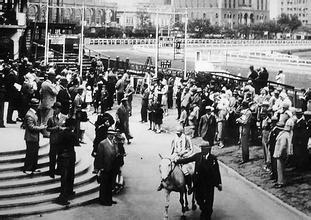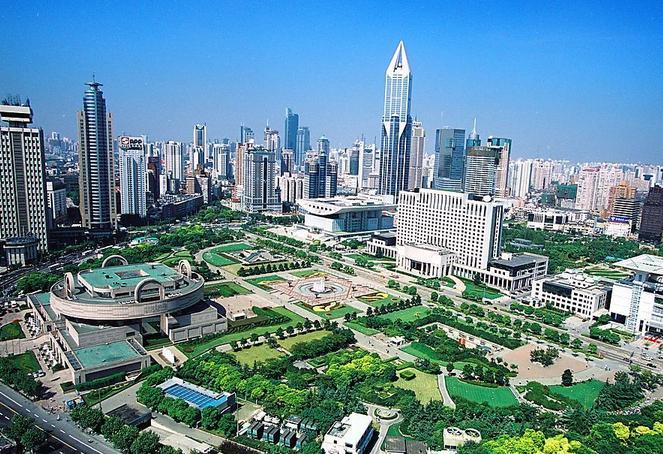The Shanghai Race Club was a horse racing club located in Shanghai, China. The Club was based at theShanghai Racecourse, and the two names are often used interchangeably.

Taste the history
Originally the Race Committee of the International Recreation Club, the Race Club was first established in 1850, with the building of Shanghai's first racecourse. In 1862, it detached itself from the Shanghai Recreation Club to become an independent body. The Club's activities were affected by the Second Sino-Japanese War and the Chinese Civil War. After the Communist takeover of Shanghai in 1949, the Club was placed under military administration in 1951 and its properties taken over by the government in 1954.

On 31 May 1954, the government took over all of the Club's buildings. The club house became, first, the Shanghai Museum, and later, the Shanghai Library. A number of other buildings were subsequently built and rebuilt on the site of the race course and club buildings. In 1997, Shanghai Library moved out to Huaihai Road, and the Shanghai Art Museum moved into the former club house. The Shanghai Art Museum moved out in 2012 to become the China Art Museum in 2012.

Look at the facilities
From 1862, the Shanghai Race Club was based at the race track it owned in the centre of Shanghai. The grounds later became People's Park and the adjacent People's Square in central Shanghai - which (taken together) are even today still in the shape of the original track. This racetrack, opened in 1862, was the third racecourse owned by the Shanghai Race Club. The turf was described as "smooth as a billiard table".

The Race Club building, which survives to this day, was built in 1934 on the western side of the race track. Its imposing, 10-storey tall tower was long a landmark of central Shanghai. It included a 100-metre (330 ft) long grand stand, with three to five levels. The 1934 building has been described thus:

The grandstand was thought at the time to be the largest in the world, and probably was, while the Race Club, with its marble staircases, teak-panelled rooms, oak parquet floors, and its coffee room which was 100ft by 47ft with a huge fireplace, most certainly ranked as the most sumptuous club of its kind yet built in any country.

The clubhouse's exterior has a neo-classical structure, with eclectic details. Aloggia which ran along the second floor of the building was used as the members' stand. The ground floor was the box office and betting hall. A mezzanine level between the ground and first floor contained bowling lanes. The first floor contained club facilities, including a cafe, games room, billiard room and reading room. The second floor contained rooms for members and the restaurant.

Feel the joy of the membership
At first, membership of the Race Club was restricted to foreign (non-Chinese) residents over the age of 21. A membership committee of 9 to 11 people would vote on each application. A unanimous approval is required for the application to succeed. If there is one disapproval vote, the application is held over until the next meeting. If there are two disapproval votes, the candidate is required to re-apply after a certain time period. If there are three disapproval votes, then the application fails and the candidate is not permitted to re-apply. It was not until 1908 that select Chinese nationals wer permitted to join as honorary members, associate members or social members. By 1908, the Race Club had 320 full members and 500 other members. Monthly fees were 10 Imperial yuan for all membership types, but membership privileges differed significantly. Non-full members could only participate in race meets on festival days. Chinese race-goers were permitted to enter the grounds from 1909.

Hear the race meeting roaring
Between 1863 and 1919, there were two meetings each year: the Spring race days occurred in late April and early May, and the Autumn race days were in late October and early November. Each meeting was for four days. The two race meetings were described as "The Grand Festivals of Shanghai". From 1920 onwards, further preliminary race days were added, and there were occasional additional races on weekends and holidays.

In the 1860s the most notable trophy was the Champions Stakes, a forced entry race for all winners during the two-day race meeting. In 1884 it was renamed the Mafoo and Champions' race. In 1927, it was renamed the Shaforce Challenge Cup and Champions' Stakes.

Betting was always a feature of the Shanghai Racecourse. Prior to 1909, this primarily occurred via bookmakers who set up stalls at the course. After 1909, the sale of raffle tickets were introduced, and quickly outstripped betting on horses as the primary source of revenue for the Shanghai Race Club. Horse racing-themed raffle tickets issued by the Race Club were sold across China. Purely a game of chance and not requiring any knowledge of racing, the raffles were very accessible and proved extremely popular with Chinese residents, and also attracted criticism of the Race Club from social commentators for running essentially a pure gambling scheme.
Think about the revival
The original Shanghai Race Club Limited, registered in Hong Kong, was dissolved in 2009. A British IT entrepreneur, Byron Constable, purchased the rights to the Shanghai Race Club brand and re-established the entity in 2008. The business operates in mainland China, and concentrates on showcasing European horse racing as a prestige lifestyle to millions of luxury goods buyers across the nation. The Shanghai Race Club also hosts the only annual Royal Ascot dinner in Shanghai which is followed by a members tour to attend Royal Ascot Ladies Day. In 2014 Miss China was one of the notable guest of the tour. The Club no longer invests in managing racecourses, nor does it organise race meets.

by Lucas












